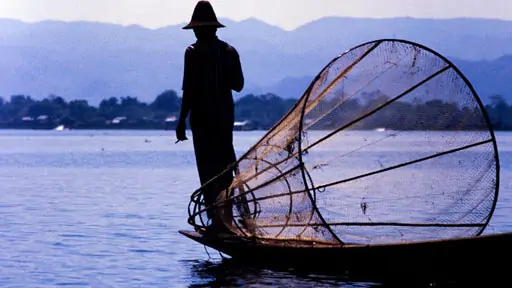Indigenous Calendar March, 2011: Modernity and Intha Tradition on Inle Lake, Burma (Myanmar)

International tourism is just one among many factors that are — directly or indirectly — changing the lives of the world's indigenous peoples. When they visit indigenous communities, tourists bring with them their own cultural identity, biases and expectations. These traits are noticed — even observed — by their hosts and, if not imitated, are at least assimilated.
Burma (Myanmar) is among the least-touristed countries in Southeast Asia; one of that country's most-touristed areas is Inle Lake in the southern part of Shan State. Since it makes a good base to visit surrounding, indigenous communities I used it as my base for about a week. I visited many communities including those of the Karen, the Taungyo and the Pa-O.
Surprisingly the lake itself is one of those communities. The most numerous ethnic group in the area is the Intha with a population of around 70,000. While the Intha live in small towns and villages around the lake some actually live on it. Here they make a living mainly from fishing. They are well known for the unique rowing style they have invented: because the lake is covered in floating plants the water is difficult to see when seated in a boat. So the Intha instead stand in their boats on one leg and "row" with the other leg wrapped around the oar. This rowing style makes for interesting photographs and I photographed many Intha fishermen at their work during my hours on the lake. I also saw people — who may or may not have been Intha — making a small income by posing this way for tourists' cameras — an example of catering to the expectations that tourists bring with them to a place like this. But I was looking for a different kind of picture to tell a different kind of story.
Although the surrounding villages are old, simple and traditional, many of their houses are, in contrast, recognizable as modern. Not on the outside from their construction but on the inside where I saw things like radios, TVs, video cassette recorders and kids wearing jeans, T-shirts and baseball caps. I realized that I wanted a picture that would somehow contrast modernity with tradition. It would have been easy to pose an indigenous person outside a traditional, bamboo-lattice village house listening to a radio or to take a photo of someone inside their house watching TV. I avoid posed photos unless my "models" can look natural enough.
One day on the lake I'd taken dozens of non-posed photographs but I was still looking for something to capture what I had imagined. Then in the distance I noticed this Intha fisherman. He must have just started fishing and appeared to be looking for an area to fish. We were close enough to the shore that some modern houses were visible and there was enough light to get both the depth-of-field and an exposure that would partially silhouette the man himself against the exposed shoreline without silhouetting his net. I had to act fast. Once the film was processed — a few weeks later — I looked at this photo and remembered that this is what I'd imagined.
If you enjoyed reading this article, please consider supporting independent, advertising-free journalism by buying us a coffee to help us cover the cost of hosting our web site. Please click on the link or scan the QR code. Thanks!


